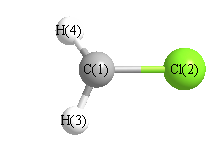Jump to
S1C2
Energy calculated at CCSD(T)/6-311G*
| | hartrees |
|---|
| Energy at 0K | -498.781902 |
| Energy at 298.15K | |
| HF Energy | -498.492803 |
| Nuclear repulsion energy | 45.113278 |
The energy at 298.15K was derived from the energy at 0K
and an integrated heat capacity that used the calculated vibrational frequencies.
Vibrational Frequencies calculated at CCSD(T)/6-311G*
| Mode Number |
Symmetry |
Frequency
(cm-1) |
Scaled Frequency
(cm-1) |
IR Intensities
(km mol-1) |
Raman Act
(Å4/u) |
Dep P |
Dep U |
|---|
| 1 |
A' |
3164 |
3045 |
|
|
|
|
| 2 |
A' |
1444 |
1390 |
|
|
|
|
| 3 |
A' |
848 |
817 |
|
|
|
|
| 4 |
A' |
230 |
222 |
|
|
|
|
| 5 |
A" |
3313 |
3189 |
|
|
|
|
| 6 |
A" |
1026 |
988 |
|
|
|
|
Unscaled Zero Point Vibrational Energy (zpe) 5012.7 cm
-1
Scaled (by 0.9626) Zero Point Vibrational Energy (zpe) 4825.2 cm
-1
See section
III.C.1 List or set vibrational scaling factors
to change the scale factors used here.
See section
III.C.2
Calculate a vibrational scaling factor for a given set of molecules
to determine the least squares best scaling factor.
Geometric Data calculated at CCSD(T)/6-311G*
Point Group is Cs
Cartesians (Å)
| Atom |
x (Å) |
y (Å) |
z (Å) |
|---|
| C1 |
0.008 |
1.125 |
0.000 |
| Cl2 |
0.008 |
-0.588 |
0.000 |
| H3 |
-0.094 |
1.623 |
0.955 |
| H4 |
-0.094 |
1.623 |
-0.955 |
Atom - Atom Distances (Å)
| |
C1 |
Cl2 |
H3 |
H4 |
| C1 | | 1.7132 | 1.0823 | 1.0823 |
Cl2 | 1.7132 | | 2.4111 | 2.4111 | H3 | 1.0823 | 2.4111 | | 1.9107 | H4 | 1.0823 | 2.4111 | 1.9107 | |
 More geometry information
More geometry information
Calculated Bond Angles
| atom1 |
atom2 |
atom3 |
angle |
|
atom1 |
atom2 |
atom3 |
angle |
| Br2 |
C1 |
H3 |
117.408 |
|
Br2 |
C1 |
H4 |
117.408 |
| H3 |
C1 |
H4 |
123.952 |
|
Electronic energy levels
Charges, Dipole, Quadrupole and Polarizability
Jump to
S1C1
Energy calculated at CCSD(T)/6-311G*
| | hartrees |
|---|
| Energy at 0K | -498.781886 |
| Energy at 298.15K | |
| HF Energy | -498.492658 |
| Nuclear repulsion energy | 45.130374 |
The energy at 298.15K was derived from the energy at 0K
and an integrated heat capacity that used the calculated vibrational frequencies.
Vibrational Frequencies calculated at CCSD(T)/6-311G*
| Mode Number |
Symmetry |
Frequency
(cm-1) |
Scaled Frequency
(cm-1) |
IR Intensities
(km mol-1) |
Raman Act
(Å4/u) |
Dep P |
Dep U |
|---|
| 1 |
A1 |
3168 |
3049 |
|
|
|
|
| 2 |
A1 |
1443 |
1389 |
|
|
|
|
| 3 |
A1 |
850 |
818 |
|
|
|
|
| 4 |
B1 |
168i |
161i |
|
|
|
|
| 5 |
B2 |
3320 |
3195 |
|
|
|
|
| 6 |
B2 |
1023 |
985 |
|
|
|
|
Unscaled Zero Point Vibrational Energy (zpe) 4817.8 cm
-1
Scaled (by 0.9626) Zero Point Vibrational Energy (zpe) 4637.6 cm
-1
See section
III.C.1 List or set vibrational scaling factors
to change the scale factors used here.
See section
III.C.2
Calculate a vibrational scaling factor for a given set of molecules
to determine the least squares best scaling factor.
Geometric Data calculated at CCSD(T)/6-311G*
Point Group is C2v
Cartesians (Å)
| Atom |
x (Å) |
y (Å) |
z (Å) |
|---|
| C1 |
0.000 |
0.000 |
-1.124 |
| Cl2 |
0.000 |
0.000 |
0.588 |
| H3 |
0.000 |
0.958 |
-1.627 |
| H4 |
0.000 |
-0.958 |
-1.627 |
Atom - Atom Distances (Å)
| |
C1 |
Cl2 |
H3 |
H4 |
| C1 | | 1.7119 | 1.0817 | 1.0817 |
Cl2 | 1.7119 | | 2.4134 | 2.4134 | H3 | 1.0817 | 2.4134 | | 1.9150 | H4 | 1.0817 | 2.4134 | 1.9150 | |
 More geometry information
More geometry information
Calculated Bond Angles
| atom1 |
atom2 |
atom3 |
angle |
|
atom1 |
atom2 |
atom3 |
angle |
| Br2 |
C1 |
H3 |
117.729 |
|
Br2 |
C1 |
H4 |
117.729 |
| H3 |
C1 |
H4 |
124.541 |
|
Electronic energy levels
Charges, Dipole, Quadrupole and Polarizability
